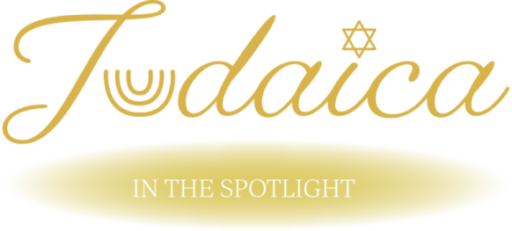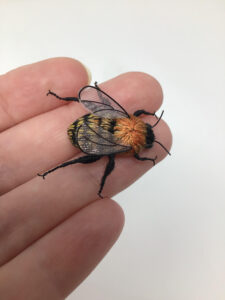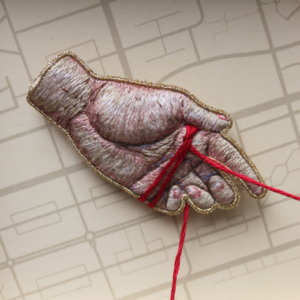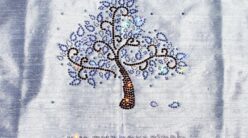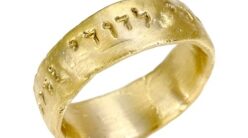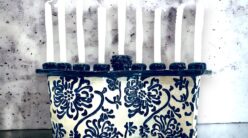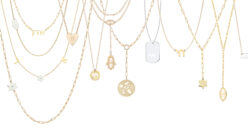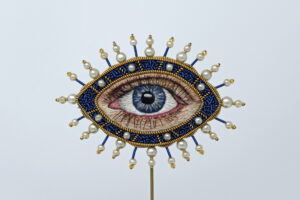
Photo: Courtesy of Tzipporah Johnston
Tell us a little bit about yourself and your background.
I grew up in Edinburgh, Scotland, but moved around a lot in my early twenties, including four years in Israel. A couple of years ago I moved back to Edinburgh and started concentrating on my art. I have an academic, rather than artistic education, and that informs my work, which is very research-driven.
What inspired you to become an artist?
I’ve always created compulsively. A couple of years ago I realised that it’s really the only thing I want to do with my life.
What is your specialty?
I’m an embroiderer and textile artist, but I also combine my textile pieces with found objects to create installations. In embroidery my specialism is stumpwork, a raised embroidery technique that creates three-dimensional elements.
How and where do you work?
Before coronavirus, I had a little studio space near the beach, but since the pandemic started I haven’t been able to get to it. I miss the structure and peace of going there to work, but I’m starting to find my rhythm working at home.
What is the most indispensable item in your studio?
My daylight lamp! The pieces I work on are so small and detailed, you need excellent light.
Where do you take your inspiration? Are you pursuing any themes?
I’m autistic, and a lot of my work is informed by that. Not always explicitly, but my autism is the prism through which I see the world. I have an ongoing installation that I add to over time, called the Museum of Monotropism, which focuses on the idea of autistic special interests. I’m also increasingly returning to Jewish themes in my work.
I also take a lot of inspiration from the natural world. A piece I’m currently working on is about the collapse in invertebrate populations in the U.K. – they’re the cornerstone of our ecosystem, but they’re declining year on year. We’ve already permanently lost two bumblebee species here, and several others are teetering on the brink.
Do you do bespoke work?
My process is very slow and laborious, so I very rarely take on bespoke work. I have made some exceptions for good causes, including a banner I’m currently working on.
What projects are you currently working on?
I have two major projects on the go at the moment. The first, The Fruit of Her Hands, is in response to the work of Jewish women sewing scrubs and masks for the COVID-19 frontline. I’m asking people to send me fabric scraps leftover from their scrub-making, which I will use to make a Torah mantle.
I have also received funding for a longer-term project, to start a collective of neurodivergent artists (artists who are autistic, dyslexic, dyspraxic, who have ADHD or other differences of neurological development) and draft a manifesto for inclusion in the arts. The deadline for application is July 31st, 2020, and the final group exhibition and manifesto launch will be in autumn 2021.
What are your favourite items in your current collection?
Probably my three-dimensional embroidered bumblebees. They are so delightful to hold, I would love to make more!
How do you know when a piece is finished?
I usually have a pretty clear sense of what I want the finished piece to look like. And as hand embroidery is so slow, you also have a lot of time while working on it to think about where it’s going.
What was the first artwork you ever sold?
I think it was a drawing of a horse that I sold to a classmate for 10p. I was about 7, and clearly very enterprising!
Which project have you enjoyed working on the most so far?
I feel very attached to The Museum of Monotropism. It’s about my autistic special interests, and composed of a mixture of my textile pieces and my collections (I am an avid collector/hoarder of interesting bits), so it’s very personal. I also enjoyed the thoughtful responses of visitors to the installation. I think many people’s idea of autism is a non-verbal five-year-old boy having a meltdown on a supermarket floor. It was good to challenge people’s perceptions about what an autistic person looked like, and to show that there is beauty in autistic ways of thinking.
What do you want to achieve with your work and what are your wishes for the future?
I try to create work that is beautiful and that makes people think. For many autistic people, the world is an exhausting, overwhelming onslaught of stimuli, and we cope by focusing on just a few things, things that make us feel calm and safe, things that most people don’t even notice. For me, that often elements of the natural world. So when I lovingly recreate a weed growing in the cracks outside my house, or blow up a tiny moth to epic size, I’m not just embroidering a pretty thing, I’m sharing how I see and cope with the world and inviting other people to stop and notice these hidden moments of beauty too. I hope in the future that autistic people will be more valued for our differences, rather than always being pathologized.
Where can we find your work?
My website is https://www.yarnandglue.co.uk/ and most of my work is there. I also have an Instagram, @tzipporahfeiga
Photos: Courtesy of Tzipporah Johnston
